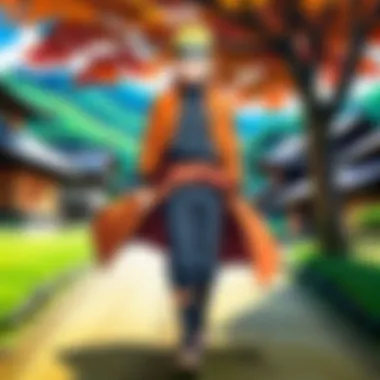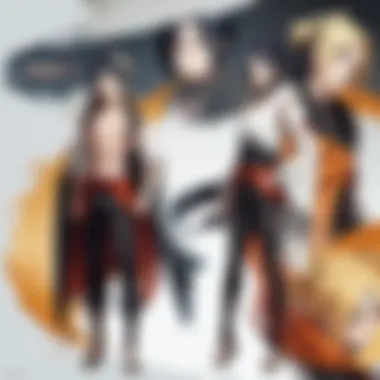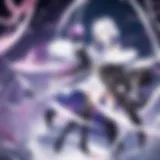Exploring Naruto Shippuden: Episodes and Themes Explained


Prelims to the Series
When you step into the world of Naruto Shippuden, you're diving headfirst into a vast universe filled with ninjas, heart-wrenching stories, and intricate character development. Originally a manga penned by Masashi Kishimoto, the series leapt onto television screens starting in 2007, wrapping up its run in 2017. The anime, like its predecessor, Naruto, blends action, drama, and fantasy, creating a compelling saga that captures the attention of a diverse audience. This journey begins after a two-and-a-half-year time skip from the original series, where we find Naruto Uzumaki, now a teenager, returning to the Hidden Leaf Village with a single goal in mind: to save his friend Sasuke Uchiha from darkness.
The journey of Naruto Shippuden is more than just a tale of epic battles and formidable jutsu. It artfully tackles themes such as friendship, sacrifice, and the pain of losing loved ones. While it may seem like a ride through ninja adventures, at its core, it’s an exploration of various societal issues, personal dilemmas, and moral questions faced by the characters. Is it any wonder that the series has garnered a massive following, not just in Japan, but across the globe? With a combined viewership that stretches into the millions and merchandise flooding the market, Shippuden stands tall among the giants of anime.
Overview of the Anime/Manga
Naruto Shippuden is classified as an action-adventure series with fantasy elements that, despite the few fantastical aspects of ninjutsu, retains a firm footing in emotional and psychological realism. The narrative continues where Naruto left off, focusing on the maturation of its characters and their evolving relationships.
Cultural Impact and Reception
The reception of Naruto Shippuden has been overwhelmingly positive, embodying a cultural phenomenon that transcends entertainment. Critics and fans alike have praised its ability to blend action with substantial character arcs, providing depth to each narrative twist. It’s spawned countless memes, fan art, and discussions on platforms like reddit.com and various social media sites.
Notably, Naruto Shippuden stands as a pinnacle in the shonen genre, often compared to other landmark series like One Piece and Bleach. Its legacy isn’t merely a collection of episodes but a testament to how anime can influence society and culture.
In essence, Naruto Shippuden is a reflection of growth, of perseverance in the face of adversity, both for its characters and its audiences. Each episode is not just entertainment; it's a piece of art that holds meaning and resonates with those who engage with it.
"In the end, the true strength of a ninja comes from having friends by your side." - Naruto Uzumaki
As we proceed through this examination, each segment will unveil not just the plot, but the heart-thumping journey of its characters, their evolution, and the craftsmanship behind this beloved series.
Foreword to Naruto Shippuden
Understanding Naruto Shippuden requires an appreciation of its various layers. It is not just a story about ninjas but a cultural phenomenon that discusses deep themes like perseverance, friendship, and the nature of conflict. This section lays the groundwork for the entire discussion by delineating the significance of the series, its historical backdrop, and its place within the broader Naruto franchise.
The importance of diving into this topic cannot be overstated. Readers can benefit from examining how Naruto Shippuden differs from its predecessor, Naruto, especially in terms of character development and storytelling complexity. The series uses its foundational elements to evolve, presenting a richer, more intricate narrative.
Overview of the Franchise
Naruto Shippuden is a continuation of the original Naruto series, which follows the journey of Naruto Uzumaki, a young ninja with a dream of becoming the strongest leader in his village, known as the Hokage. Released after a significant gap from the first series, Shippuden picks up two and a half years after the original story. In this segment, Naruto's quest deepens as he faces more formidable challenges and uncovers his own identity amidst growing threats.
The franchise has a massive global following that spans generations. Many fans first encountered Naruto as adolescents, sharing the character's struggles and triumphs, making it a symbol of their own growth. The influence of the series extends beyond entertainment; it fosters discussions about ethics and morality, as well as the value of teamwork and resilience in the face of adversity.
Historical Context of the Show
Naruto Shippuden debuted in 2007, a time when anime was becoming increasingly mainstream in Western culture. This period was characterized by a surge in streaming platforms that made accessing foreign media easier. Shippuden quickly captivated audiences not only for its action-packed sequences but also for its exploration of complex themes that resonate with real-world issues like loss, responsibility, and the importance of pursuing one's dreams despite hardships.
The context in which Naruto Shippuden emerged also contributed to its relevancy. The aftermath of global events saw a rise in narratives emphasizing hope and determination, making Naruto’s story particularly poignant for its audience. Furthermore, it served as a bridge connecting traditional storytelling with modern animation technology, showcasing character depth and unique battle choreography at levels that were previously unseen.
As such, understanding the historical perspective of Naruto Shippuden helps to frame its cultural significance as an anime series. Through its unique narrative approach and character arcs, it engages viewers on multiple levels, making it not only a source of entertainment but also of introspection and learning.
The Significance of the English Dub
When diving into the world of Naruto Shippuden, one cannot overlook the role that the English dub has played in its widespread acceptance and popularity. The significance of the English adaptation reaches far beyond merely translating the original dialogues; it encompasses bringing a nuanced interpretation of the characters and stories to a broader audience that may not be fluent in Japanese. This section aims to highlight the essential elements and benefits associated with the English dub, illustrating its contribution to the anime's cultural impact.
Impact on Accessibility
The English dub has significantly widened the audience reach of Naruto Shippuden. For many viewers, engaging with an anime in its original language can be daunting. The combination of rapid dialogue and cultural nuances can create barriers. The dub breaks these barriers by offering a voice to characters that resonates with English-speaking audiences. This accessibility is vital in attracting new fans who might otherwise overlook the series due to language constraints.
Consider the several attributes that result from this adaptation:
- Voice Acting Choices: The skillful casting of voice actors brings characters to life, infusing them with not just words but personality. Naruto's enthusiasm and Sasuke’s brooding nature resonate powerfully—traits accessible due to voice performance.
- Contextual Understanding: The English dub often adapts cultural references, making them relatable for Western audiences. For instance, the way ninjas are portrayed through the lens of a Western setting draws parallels with heroic archetypes familiar to the audience, thereby enhancing character relatability.
- Emotional Engagement: A well-voiced English adaptation can evoke stronger emotional responses. For many fans, the English voice cast’s delivery of pivotal moments is what resonates most deeply, reinforcing connections with the characters.
The reach of the English dub is undeniably influential, encouraging a curious mind to explore the depths of Japanese storytelling, ultimately leading audiences to the wonderful world of anime as a whole.


Cultural Adaptation Challenges
While the English dub expands accessibility, it also presents a unique set of challenges regarding cultural adaptation. Translating nuanced phrases and idioms requires a careful balance to preserve meaning while ensuring the narrative flows naturally in English. Here are some of the challenges faced:
- Loss of Cultural Nuances: Some original phrases or references can lose their essence in translation. For example, jokes that work in Japanese culture may not translate well into English, leading to altered humor and potentially misunderstood situations.
- Character-Centric Adaptation: Each character embodies various cultural traits. Adapting these nuances to fit the English-speaking context can be tricky. Some may argue that significant aspects of a character’s personality could be diluted in translation.
- Original Intent vs. Market Considerations: The need to make a series appealing and appropriate for a specific market can lead to changes that misalign with the creator's original intent. This may include altering specific scenes or character behaviors that are deemed unsuitable for the intended audience.
Overall, navigating these challenges requires an intricate understanding of both cultures, striving to maintain storytelling integrity while making it accessible to a new audience. The English dub's ability to innovate within these confines has, at times, led to a distinct secondary identity for Naruto Shippuden, ensuring its place in global pop culture.
Major Themes in Naruto Shippuden
The themes explored throughout Naruto Shippuden are integral to understanding the narrative's depth and its reception among fans. Each theme resonates with the characters and story arcs, ultimately inviting viewers to reflect upon their own lives and relationships.
Exploring these themes allows for a richer examination of what makes this series special. It speaks to the complexities of human emotions, the struggle for acceptance, and the importance of companionship. As we navigate through the episodes, these recurring motifs guide the viewer in grasping the series’ profound messages.
Friendship and Loyalty
Friendship and loyalty are cornerstones in Naruto Shippuden, shaping the relationships between characters and driving the plot forward. The bond between Naruto and his friends illustrates this theme brilliantly. Despite the unique challenges they face, their unwavering support for each other stands out.
This loyalty is multifaceted. Consider the way Naruto, despite his turbulent past, is committed to bringing Sasuke back to the village. Here, friendship isn't just a casual bond; it's a powerful force that influences decisions and ultimately leads to personal growth.
The show’s narrative often highlights how true friendship can lead to redemption. For instance, when Sakura Haruno supports Naruto even when he is at his lowest, it showcases that friendships can heal. Without this theme, the evolution of characters like Naruto and Sasuke would feel hollow and incomplete.
The Quest for Identity
Identity is another significant theme that pervades Naruto Shippuden. The series delves deep into what it means to find one’s place in the world. Naruto’s journey from a lonely outcast to the hero of Konoha reflects a universal struggle for self-discovery.
Throughout the episodes, audiences witness Naruto grapple with societal expectations and the pressure to fulfill the prophecy of being Hokage. This quest is not just about external recognition but also about internal acceptance. The question of, "Who am I?" looms large over countless characters. The search for personal identity is poignantly illustrated in Sasuke’s arc as he wanders down the path of revenge, only to realize that his identity is deeply interwoven with his home and his friendships.
This theme encourages viewers to reflect on their own journeys—the battles they face to align self-perception with how they are perceived by others.
Conflict and Resolution
Conflict shapes the narrative structure of Naruto Shippuden. Almost every episode hinges upon some form of conflict—whether internal struggles or external battles. These conflicts serve as catalysts for character development and thematic exploration.
The series does a stellar job of showcasing various conflicts, not just physical fights but emotional and moral dilemmas as well. For example, characters often face choices that reveal their values, like Naruto’s decision to forgive his enemies, inviting the audience to ponder the nature of justice and redemption.
Resolution is equally nuanced. The way conflicts are resolved often steers the narrative toward messages of reconciliation and understanding. The climactic battles serve as a backdrop for not merely defeating opponents but for understanding their pain and transforming it into a shared experience. It is through these conflicts and their resolutions that character arcs come full circle, reflecting the complexities of real-life relationships.
Ultimately, the themes of friendship, identity, and conflict in Naruto Shippuden create a rich tapestry that not only entertains but also resonates on a personal level with its audience.
Character Development Analysis
Character development serves as the backbone of Naruto Shippuden, shaping the narrative and resonating with its audience throughout the series. The evolution and growth of characters not only reflect their personal struggles but also embody larger themes about friendship, conflict, and redemption. By examining the arcs of key protagonists and supporting characters alike, we gain insight into how these developments are intricately woven into the fabric of the story.
Naruto Uzumaki's Transformation
At the starting blocks of Shippuden, Naruto Uzumaki is a brash and impulsive ninja, often overshadowed by the immense legacy of others, particularly that of his parents and his peers. As the series progresses, viewers witness his metamorphosis into a figure of strength and resilience. Significantly, the pressures and expectations placed upon him foster a deeper sense of purpose.
His growth is multidimensional. From the innocent boy seeking acceptance, he transforms into a strategic thinker and a capable leader, particularly during the Fourth Great Ninja War. This evolution emphasizes not just physical prowess but an emotional and psychological journey.
"Naruto's journey is a poignant reminder that true power lies in understanding oneself and others."
The way he navigates through loss—like the death of his mentor Jiraiya—and the burden of his Nine-Tails demon serves to highlight his resolve and determination. Ultimately, his character embodies the theme of perseverance against adversity.
Sasuke Uchiha and Redemption
In stark contrast to Naruto, Sasuke Uchiha's trajectory is greatly marked by revenge and betrayal. Initially driven by a singular goal to avenge his family's murder, Sasuke's journey delves into the darkness of vengeance. However, his path towards redemption adds depth to his character.


Throughout Shippuden, Sasuke's interactions—chiefly with Naruto—become pivotal in steering him away from self-destruction. The themes of rivalry and friendship illuminate his character arc, ultimately compelling him to confront his past and acknowledge the consequences of his actions. His final decisions show that redemption is never a straight path but a winding road filled with challenges.
Supporting Characters' Arcs
Behind Naruto and Sasuke's overt transformations lie the intricate stories of supporting characters, each contributing to the overall narrative tapestry. Characters like Sakura Haruno, Kakashi Hatake, and Jiraiya are more than just side players; they engage in profound personal journeys that enhance the main storyline.
- Sakura Haruno evolves from a lovesick girl into a formidable kunoichi, proving her capabilities beyond just being Naruto's friend or Sasuke's admirer. Her journey reflects themes of strength, both emotional and physical.
- Kakashi Hatake, with his mysterious past, showcases growth as a mentor. His battle with his own demons and the burden of leadership is a testament to the series' deeper exploration of what it means to protect those you care for.
- Jiraiya stands as a mentor to Naruto but also as a tragic figure, embodying the theme of sacrifice in pursuit of a greater good.
In summary, the character development within Naruto Shippuden provides not just entertainment but also reflection on the human experience. Each arc serves to underline significant themes, propelling the audience to connect on multiple levels, and these narratives contribute greatly to the show's long-lasting impact on anime culture.
Episode Breakdown
The episode breakdown of Naruto Shippuden plays a vital role in understanding the show's overall narrative and significance. It offers insight into how various story arcs unfold over multiple seasons and highlights pivotal moments that shape character journeys. This section serves not merely to catalogue episodes, but also to explore their thematic weight and how they contribute to character development and narrative consistency.
Structuring episodes into seasons allows viewers to grasp the pacing and evolution of the storyline. Each season is defined by distinct arcs that often encompass both recurring characters and overarching themes. By understanding which episodes are key and why they are considered so, fans can appreciate the craft of storytelling involved. Analyzing specific episodes also sheds light on how Naruto Shippuden keeps its audience engaged while portraying deep philosophical questions and moral dilemmas.
Season Structure and Key Episodes
The structure of seasons in Naruto Shippuden impacts the viewer's journey through the series. Each season carefully sequences episodes to escalate the tension and develop characters incrementally. For instance, the early seasons focus on Naruto's growth, the evolution of his relationships, and the gradual uncovering of larger plots involving the Akatsuki. Season 5, arguably one of the most celebrated, is characterized by pivotal episodes like Episode 152, which showcases intense battles intertwined with character resolutions.
Noteworthy episodes within each season serve like landmark stones on a traveler’s path through the series. Certain episodes are celebrated not only for their action sequences but also for the character revelations they offer. For example:
- Episode 168 - "The Fourth Hokage": This episode unpacks Naruto's lineage and his connection to the Fourth Hokage, a moment that echoes throughout the narrative.
- Episode 500 - "The Last episode": With emotionally charged farewells, it concludes arcs while setting the stage for future developments.
Notable Filler Episodes and Their Importance
Filler episodes in Naruto Shippuden often bear the brunt of criticism, yet they also hold significant value in enriching the main storyline. These episodes provide room for character exploration that might not be feasible during the intense arcs. Filler episodes can delve into the backgrounds of secondary characters, enriching the viewer's understanding of their motivations.
For instance, Episode 222, featuring the Twelve Guardian Ninja, stands out. It might not directly tie into the main plot but showcases the camaraderie and sense of duty that runs akin to Naruto's journey. Such fillers, often seen as mere distractions, reveal deeper connections that contribute to the world-building in the series.
Moreover, filler episodes often offer comic relief and emotional depth, bridging complex arcs with lighter narratives. They can serve as poignant moments for character development that might otherwise go unexplored amidst the high-stakes situations prevalent in core arcs.
In essence, although it might be tempting to skip fillers, understanding their place elevates the viewing experience and provides a more enriching appreciation for the Naruto universe as a whole.
Narrative Techniques Employed
When delving into the world of Naruto Shippuden, it's vital to explore the narrative techniques used throughout the series. These elements craft the viewer's experience and provide a deeper understanding of the stories being told. The use of specific techniques is essential for engaging audiences and delivering themes weaved intricately into the plot. Let's break down some key components: story arcs and pacing, along with the use of flashbacks and foreshadowing.
Story Arcs and Pacing
Naruto Shippuden employs carefully structured story arcs that unfold over multiple episodes, allowing for complex character development and plot progression. Each arc presents a unique challenge or conflict, contributing to the overall narrative while also maintaining the audience’s interest through effective pacing. Take, for example, the "Kazekage Rescue" arc, where Naruto and his friends venture out to save Gaara. This arc not only strengthens their bonds but also showcases the growth each character has undergone. The pacing here is deliberate; it manipulates tension skillfully, alternating between fast-paced action scenes and quieter, introspective moments that allow the audience to reflect on character motivations.
Moreover, the strategic layout of arcs ensures that the storyline maintains momentum. One arc smoothly transitions into the next, making it hard to pull oneself away from the unfolding drama. The finale of one segment typically teases what’s to come, compelling viewers to keep on watching. This careful balance of pacing and structure creates a rhythm that mirrors the emotional ebb and flow of the characters’ journeys. The immersive quality encourages audiences to become invested in not just the outcome of conflicts, but in the growth and evolution of the characters themselves.
Use of Flashbacks and Foreshadowing
Flashbacks are a staple in Naruto Shippuden, serving to deepen the narrative and illuminate the backstories of key characters. They allow viewers to grasp the motivations behind characters’ actions and decisions by shedding light on their past experiences. For instance, Naruto’s recollections of his childhood struggles enable the audience to empathize with his quest for recognition. It connects the viewer to his present journey, illustrating how past events shape one’s identity.
On the other hand, foreshadowing plays a formidable role in building anticipation and suspense. The careful inclusion of hints about future conflicts keeps fans actively engaged. A prime example can be found in the early episodes of the series where subtle references to Sasuke's eventual confrontation with Naruto drop breadcrumbs that lead to later, explosive clashes. This technique encourages viewers to pay close attention, rewarding them as the narrative threads come together in unexpected ways.
In summary, the narrative techniques in Naruto Shippuden—particularly story arcs, pacing, flashbacks, and foreshadowing—are not just stylistic choices; they are foundational elements that enrich the storytelling. These techniques enable the series to maintain a captivating flow, bridging the gap between character development and broader themes, ultimately leading to a cohesive and satisfying viewing experience.
“The story is the backbone that supports character development while engaging the audience emotionally.”
Whether one is a longtime fan or a newcomer to the series, recognizing and understanding these narrative devices can greatly enhance one’s appreciation of Naruto Shippuden. They are the threads that tie the rich tapestry of the series together, making it not just a show, but a critical cultural phenomenon in the world of anime.


Artistic and Technical Aspects
The artistic and technical aspects of Naruto Shippuden are essential to understanding its overall impact and effectiveness. Animation quality, sound design, and musical composition all play critical roles in how the story and characters are perceived by the audience. These elements work in tandem to convey emotions, enhance storytelling, and create a vivid universe that captivates viewers.
Animation Quality Across Seasons
Throughout its airing, Naruto Shippuden demonstrated varied animation quality across different seasons; this variability has been both praised and critiqued by fans and scholars alike. In the early seasons, the animation retained a somewhat traditional approach, closely aligned with the original manga style. However, as the series progressed, viewers noticed that the animation quality fluctuated significantly.
Some standout episodes featured fluid movement and detailed character designs—such as in pivotal battles like Naruto versus Pain—exhibiting a remarkable level of craftsmanship. Conversely, there were also instances where the animation appeared rushed or less refined, especially in filler episodes.
Key aspects of the animation quality include:
- Character Design: Each character's design evolved, reflecting their internal changes or growth over time.
- Action Sequences: Choreography of fight scenes became a visual feast, showcasing strong techniques and dynamic camera angles.
- Emotional Expressions: The use of exaggerated facial expressions enhanced the narrative, allowing viewers to connect more deeply.
Ultimately, it’s essential to recognize how these artistic choices affect viewer engagement. A high-quality animation can turn a mundane scene into something critical, creating a lasting impression that resonates long after the credits roll.
Soundtrack and Musical Elements
The soundtrack of Naruto Shippuden is not merely a backdrop; it is a character in itself. Composed by Yasuharu Takanashi, the series features a blend of traditional Japanese instruments and modern orchestration. The music encapsulates the essence of each arc, underscoring the emotional highs and lows faced by the characters.
Key Components of the Soundtrack:
- Theme Songs: Opening and ending tracks often set the tone, reflecting the themes of each season. For instance, Blue Bird by Ikimonogakari became iconic, symbolizing freedom and hope.
- Background Scores: The use of ambient sounds and orchestral pieces enhances crucial moments. The music during Naruto's transformational scenes often intensifies the audience’s emotional response.
- Character Motifs: Each major character has distinct musical themes that complement their story arcs, reinforcing their challenges and victories. For example, Sasuke’s theme evokes feelings of tension and conflict, while Naruto's theme celebrates perseverance and resolve.
“Music is the universal language of mankind.” - Henry Wadsworth Longfellow
Cultural Impact of Naruto Shippuden
Naruto Shippuden has become more than just an anime; it's a cultural phenomenon that’s woven its way into the fabric of global entertainment. The series showcases a wealth of themes and character developments that resonate widely, impacting not just fans but also creators and the industry alike.
Influence on Anime Culture
The impact of Naruto Shippuden on anime culture is hard to overstate. It has set new standards for storytelling and character arcs, influencing a generation of anime creators. In particular, its ability to blend action with deep emotional themes has inspired countless shows that followed. This series pioneered a style that emphasized character development and intricate plots, moving away from one-dimensional heroes.
For instance, protagonists like Naruto and Sasuke aren't just about their ninja skills; their struggles with identity, friendship, and rivalry have struck a chord at home and abroad. This depth has encouraged similar narratives in productions such as My Hero Academia and Attack on Titan, creating a ripple effect within the medium.
Furthermore, Naruto Shippuden's popularity helped legitimize anime as a serious form of entertainment on a global scale. It broke barriers, facilitating anime conventions worldwide and encouraging official screenings in various languages. The series opened the door to platforms like Crunchyroll and Funimation, which championed accessibility to anime, allowing fans to engage with the content like never before.
Fan Community Contributions
The fanbase of Naruto Shippuden is diverse and vibrant, contributing significantly to its cultural impact. Various forums, like Reddit, overflow with fan theories and discussions, deepening the viewer's connection to the series. From Reddit to Facebook groups, these spaces allow fans to share fan art, speculations, and new interpretations, which keeps the conversation alive and kicking.
Creative contributions from fans also take form through fanfiction and art. Many artists showcase their interpretations of beloved characters, while writers expand on storylines through fanworks, creating a rich tapestry of fan-made content. This grassroots activity not only celebrates the original material but also fosters a sense of community among fans.
Moreover, events like Naruto-themed cosplay competitions at conventions let fans embody their favorite characters. This empowerment through cosplay blurs the lines between creator and consumer, transforming fans into active participants within the Naruto universe.
In summary, the cultural impact of Naruto Shippuden is significant. Its influence extends far beyond the screen, affecting industry practices and inspiring a committed community. It’s a series that has shaped anime, provided a plethora of stories for fans, and set the groundwork for future works. As we delve deeper into concepts laid out in this article, the importance of Naruto Shippuden becomes even clearer.
Ending
In wrapping up this exploration of Naruto Shippuden, it is essential to underscore the significance of the series, transcending merely animated entertainment. The narrative intricacies woven throughout the episodes reveal profound themes that resonate deeply with a wide audience. Themes such as friendship, loyalty, and the struggle for identity are not just plot devices but reflect a broader commentary on human experience, making the series relevant to viewers from all walks of life.
Summary of Key Points
To summarize the essential points discussed in the article:
- Cultural Impact: Naruto Shippuden has significantly shaped anime culture, inspiring countless works and dedicated fan communities.
- Character Development: The transformation of core characters, particularly Naruto and Sasuke, showcases a deep exploration of redemption and growth.
- Artistic Techniques: The animation quality and music have elevated the series, enhancing emotional depth.
- Global Reach: The English dub has made the series accessible, allowing it to permeate cultures beyond Japan.
This comprehensive look at different aspects of Naruto Shippuden gives fans a richer understanding, not just of the plot but the artistry and themes embedded within.
Future Outlook for the Franchise
Looking ahead, the Naruto franchise shows no signs of slowing down. Spin-offs like Boruto reflect a continued interest in the Naruto universe, offering fresh perspectives and new characters, while older fans remain engaged with various adaptations and content.
- Cross-Media Expansion: With games, novels, and films stemming from the original series, the potential for storytelling in this rich universe is vast.
- Global Fan Involvement: As the anime community continues to grow, so does fan involvement in the creation and interpretation of Naruto's legacy.
- Merchandising Trends: The franchise remains popular in merchandising, indicating a strong commercial viability.
The way forward for Naruto is not merely to rest on its past laurels but to adapt and evolve, potentially reaching even broader audiences in years to come.















